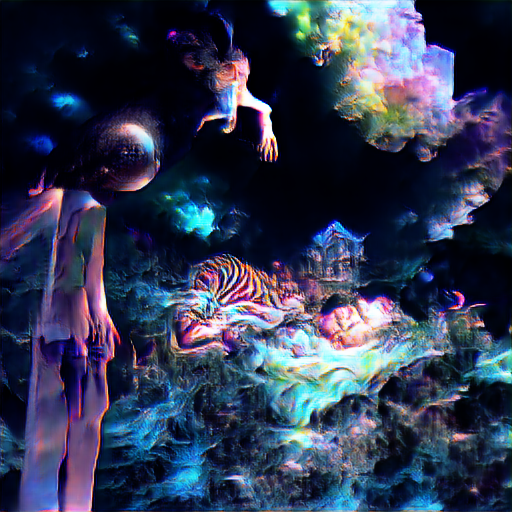Lucid dreaming
|
Lucid dreaming | |
|---|---|

computer prediction of "lucid dream" |
Lucid dreaming is a term used to describe a type of dream characterized by the dreamer's becoming aware that they are dreaming whilst retaining the sense of self.
This awareness may come from a variety of sources ranging from a voice in the dream to a waking sense of "lucidity" which is an awareness of the dream-world as an imaginary construction.
Definition[edit]
The term lucid dream was coined in the 20th century by the Dutch scientist and parapsychologist Frederik van Eeden. 1 He used it to describe his own recurring dream; while dreaming he would become aware that he is dreaming, but would be unable to remember the dream upon waking. While it is a common assumption that dreamers are able to remember their dreams, in van Eeden's experience this was not the case and instead he would wake up remembering the dream but unable to recall the content of the dream. This unique property of lucid dreams, in which the dreamer becomes aware they are dreaming, but remain unable to remember the content of the dream upon waking, led van Eeden to coin the term "lucid dream". He considered this to be a unique and important property of lucid dreams to study.
History[edit]
Lucid dreams have a long history within philosophical thought and religious thought. Aristotle's "De Somno et Vigilia" (On Sleep and Wakefulness) suggests that lucid dreams can be explained as a special form of dream, in which the dreamer is aware that they are dreaming whilst the dream continues, and therefore he is aware that he is not the dreamer. Lucid dreaming was also noted by the Hindu philosopher Kautalya (3rd century BC), the Hohgene Kojiki (8th century AD) and the Islamic scholar Avicenna (c. 980). The aforementioned De Somno et Vigilia was rediscovered in Western Europe during the 16th century. In 1960 the book The Occult by the philosopher C. D. Broad (1957) contained a chapter, "Toward a Theory of the Lucid Dream", which discussed the history of the concept of lucid dreams.
Typical characteristics of lucid dreams[edit]
Lack of awareness of physical body: There is no awareness of physical body whilst lucid dreaming, which is also referred to as out-of-body experience or astral travel. It is possible to feel as if you are in two places at once, that you are falling, or that there are no physical laws in effect. This is because your consciousness is considered to be partially detached from your physical body (as in the lucid dream), but this unusual duality is not noticed by the dreamer as it is an unconscious experience.
In popular culture[edit]
Lucid dreaming was featured in the film "Inception" (2010) where the main characters use a special technique to enter the dream of the target and manipulate the dream world so that they will be able to create a physical appearance to infiltrate their target. The film "Monty Python and the Holy Grail" (1975) contains a scene in which the Knight (Graham Chapman) has a lucid dream that he is chased by a swarm of bees. He wakes up in a panic, causing the alarm clock to go off.
Film[edit]
Lucid dreaming has been featured in a number of films and television series, including The Sixth Sense, in which two of the characters Milo and Mrs. Thomas (Toni Collette) had a conversation about their respective dreams. In the film "Inception" (2010) the main character, Dom Cobb (Leonardo DiCaprio) is able to enter the dream world of his targets and manipulate the dream within his surroundings. It has also been featured on the show "The Simpsons" (1989) when Bart (Nancy Cartwright) had a lucid dream after being given a medication for insomnia. In the film "Inception" (2010) some of the characters in the film enter the dream world and attempt to manipulate the dream world.
Television[edit]
Lucid dreaming has been shown on television in the series "Desperate Housewives" (2004) during the episode "How to Make a Killing inATERA". During the episode, the main character Gabrielle Solis (Eva Longoria) becomes lucid in her dream, and realizes that she had been living in the dream world all along, and that she is able to manipulate the dream world into creating new rooms and items within the dream. The main character of the MTV series "Teen Wolf" (2011) is also shown to have lucid dreams, in which he can project himself outside of his body.
Literature[edit]
Lucid dreaming has been featured in many works of literature. In the novel "Infinite Jest" (1996) by David Foster Wallace, a boy has one lucid dream, in which he discovers that the world is a video game. In the novel "The Book of Unwritten Tales" (2008) by Theodor Storm, the main character is in a dream world where he meets a cat who helps him to find the key to move forward in the story. In the novel "The Dream-Quest of Unknown Kadath" (1926) by H.P. Lovecraft, the main character Prince Denethor II (Sacha Dhawan) is asleep when he has a dream. In the book "One morning in the life of Ivan Denisovich" (1962) by Aleksandr Solzhenitsyn, a character named Warden has a lucid dream in one chapter.
See also[edit]
Lucid dreaming is similar to astral projection, which is the act of projecting one's consciousness outside the physical body to travel to other places. Lucid dreaming differs from astral projection in that the dreamer is aware they are dreaming and that their consciousness is not 'projected' outside the body, but instead has a detachment from their physical body. It will also differ from dream-sharing, in which two or more people share the same dream, as this definition of lucid dreaming requires the dreamer to be aware they are dreaming whilst dreaming.
References[edit]
Beyerstein, B.L. (2005). Lucid dreaming: An updated review of theory and research. "Dreaming", 13(1). pp. 1–10.
